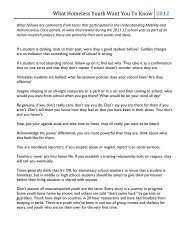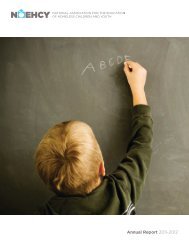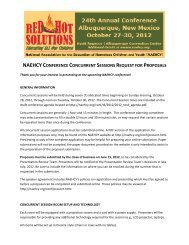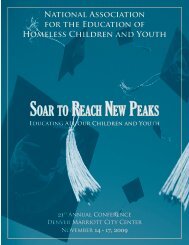The McKinney-Vento Act and Children and Youth ... - State of Michigan
The McKinney-Vento Act and Children and Youth ... - State of Michigan
The McKinney-Vento Act and Children and Youth ... - State of Michigan
You also want an ePaper? Increase the reach of your titles
YUMPU automatically turns print PDFs into web optimized ePapers that Google loves.
This residential instability too <strong>of</strong>ten leads to instability in school. Several<br />
studies have shown that youth in out-<strong>of</strong>-home care change schools much<br />
more <strong>of</strong>ten than other youth. For example:<br />
• A New York study found that 65% <strong>of</strong> children placed in foster care<br />
had changed schools in the middle <strong>of</strong> the school year. 15<br />
• A study in Washington <strong>State</strong> found that when compared to youth<br />
not in foster care, twice as many youth in care changed schools. 16<br />
• <strong>Youth</strong> who are entering foster care for the first time are most<br />
vulnerable to school mobility, as over two-thirds switch schools<br />
shortly after they enter care. 17<br />
<strong>The</strong> residential <strong>and</strong> educational instability <strong>of</strong> youth experiencing<br />
homelessness <strong>and</strong> <strong>of</strong> those in out-<strong>of</strong>-home care is a significant similarity<br />
between the populations. Furthermore, sometimes the same youth are both<br />
homeless <strong>and</strong> in out-<strong>of</strong>-home care. For example, many older youth run away<br />
from child welfare placements they perceive to be inappropriate, finding<br />
homelessness preferable to the placement the child welfare system <strong>of</strong>fers.<br />
Other youth remain in care until they turn 18, only to become homeless<br />
upon being discharged from the system. Some youth enter care upon being<br />
removed from the custody <strong>of</strong> parents who are homeless.<br />
Despite their important similarities <strong>and</strong> overlap, there is at least one critical<br />
difference between youth in out-<strong>of</strong>-home care <strong>and</strong> those experiencing<br />
homelessness: youth in out-<strong>of</strong>-home care are in the care <strong>of</strong> a public agency.<br />
This agency provides a team <strong>of</strong> advocates charged with guarding the youth’s<br />
safety, seeking permanency, <strong>and</strong> addressing their well-being, including their<br />
educational well-being. When this child welfare team <strong>and</strong> the public schools<br />
collaboratively focus on the needs <strong>and</strong> goals <strong>of</strong> the youth in their care,<br />
educational success for youth in out-<strong>of</strong>-home care is an attainable goal.<br />
On the contrary, there is no public agency, system, or appointed advocates<br />
responsible for caring for youth who are homeless. <strong>The</strong>y lack this important<br />
asset. <strong>The</strong> only public system required by law to care for youth experiencing<br />
homelessness is the public school system. <strong>The</strong>refore, the <strong>McKinney</strong>-<strong>Vento</strong><br />
<strong>Act</strong> <strong>and</strong> the educators who implement it are a critical support for these young<br />
people.<br />
Strategies for Improving Educational Outcomes through School Stability 9














